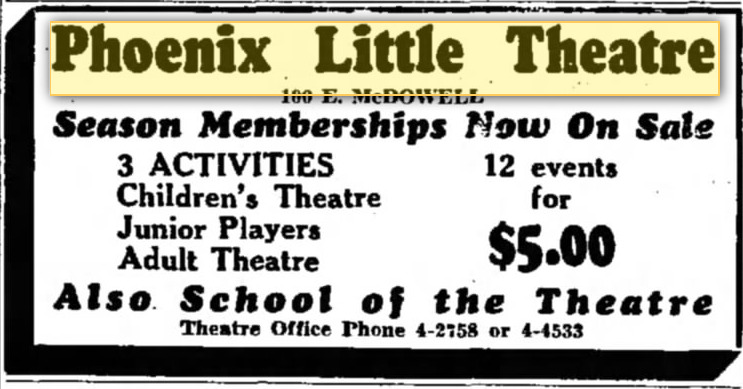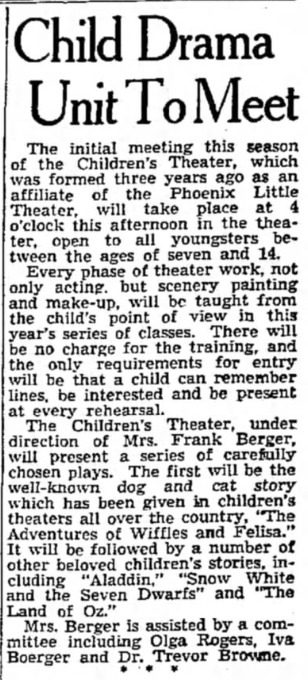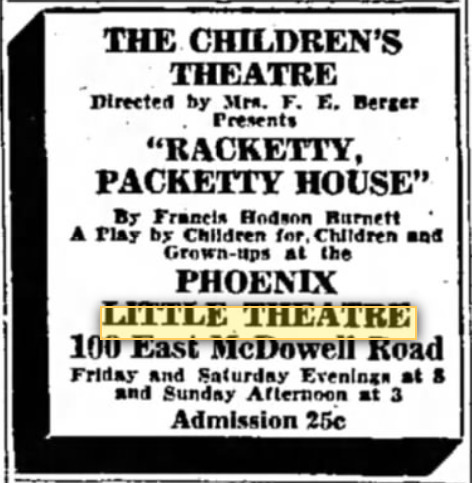This page contains items pertaining to Phoenix Theatre in the 1930s. For a general history of the company go to the main page.
Phoenix began the ’30s with a population of 48,118. The number of telephones increased to more than 15,600. NBC became the first national network to air in the Valley in 1930, broadcasting from KTAR’s tower atop the Westward Ho Hotel. In a hallmark of advancing civilization, Holsum Bakery began selling sliced white bread in 1931. American Airlines started flying between Phoenix and Tucson in 1932. Work began on Encanto Park in 1934 and, a year later, the city purchased Sky Harbor Airport. In 1934, the city was rocked by its first major civic scandal: Mayor F.J. Paddock was sent to prison for three years after being found guilty of income tax evasion. Joseph S. Jenckes, whose family was active at Phoenix Little Theatre, became mayor.
You may take children’s theater for granted but it wasn’t always so. Although there were activities for youngsters that involved theater in one form or another, it wasn’t until Dorothy Seifert Dodge began a series of programs designed especially for youth at Phoenix Little Theatre in the early 1930s that the concept took root.
Called the Curtain Pullers, the group produced family friendly fare such as Cinderella and Snow White and the Seven Dwarfs.
Olga Rogers began a program called the Phoenix Junior Players for high school and junior college students. The group performed and rehearsed at PLT and made its debut in January, 1935.
PLT also facilitated the theatrical interests of adults with classes in diction, makeup, stage technique and contemporary drama led by Mrs. Dodge, Mrs. Wayland Brown and Walter Ben Hare. These sessions were so popular that often potential students had to be turned away.
During the ’30s, Phoenix Little Theatre presented other little theaters’ productions at the Old Coach House, including those by Mesa Little Theatre.
In 1937-1938, the company’s budget was slightly more than $2,000. As of Sept. 15, 1937, it listed of revenues of $2,278.71 against expenditures of $1,523.71, leaving it in the black to the tune of $755.
Stephen C. Shadegg, former director of the Laguna Beach Theatre in California, begins his long association with PLT as guest director of One Hundred Years Old during the 1932-’33 season.
The membership was exposed to a wide variety of readings and one-act plays throughout the 1930s. Membership meetings, held at the theater or in homes of members, featured entertainment programs of one-acts directed and acted by PLT members.
Often this was an opportunity for fledgling directors to test their skills and to prove themselves before being awarded a directorial assignment as a part of the theater’s season.
These programs were an effective way of recruiting new members, as these special performances were open only to active members.
In the late 1930s, Phoenix Little Theatre had a Sunday program on KOY Radio called Phoenix Little Theatre of the Air. It was a mishmash of material that promoted upcoming or current plays and presented PLT actors in selected scenes. Each segment was approximately 15 minutes. Jeanne Paquette and Jack Wages made frequent appearances.
BOARD OF DIRECTORS
- 1930-1931 Frank Duffy, James Shelly.
- 1931-1932 Henry Cate.
- 1932-1933 Brenda Weisberg Meckler.
- 1933-1934 Dan Hendersen.
- 1934-1935. Warren Hunter.
- 1935-1936 Dr. Trevor Brown.
- 1936-1937 Mrs. Virgil Bledsoe.
- 1937-1938 Dow Ben Roush, Dr. George Thorngate.
- 1938-1939 Mrs. Wayland Brown.
- 1939-1940 Ernest Johnson.
- During the 1932-1933 season, the board presented a satire on Hollywood’s publicity methods, coupled with a pledge to raise PLT’s membership to 500.
BOUND FOR GLORY – WITH A SLIGHT DETOUR
In the 1930s, a young Kingman actor took to the stage at PLT. When I first came to the Valley in the late 1970s, old-timers still remembered Andy Devine.
“I think the thing that stood out most about Andy was his voice,” David Berge told me in a 1977 interview. “It sounded like you were scraping the bottom of a barrel. The directors didn’t know what to do with him. But he was such a likeable kid that one of them finally gave him a part. I think he had two or three lines. The problem was, he was so scared he couldn’t remember them on opening night. He went up. That scared him even worse. He ran off stage – only where he thought there was a door, there was a window. He went right through it. Everyone gave him hell – in a funning way – after that. It wasn’t long before he went off to Hollywood.”
Andy had much better luck at the studios. He soon was being cast (or miscast as in 1936’s Romeo and Juliet as one of Juliet’s servants) in big productions like In Old Chicago and A Star Is Born. In 1939, he was back in his home state in one of his most memorable roles, the driver in John Ford’s classic western, Stagecoach. — Kyle Lawson.
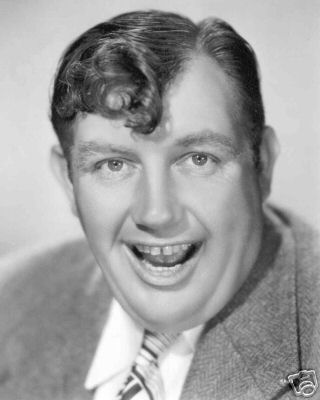
THE PRODUCTIONS
- 1930-1931
- Honeymoon
- Holiday
- Mis’ Nelly of N’Orleans
- The Show-Off
- Director: Dr. F.L. Reese.
- The Silver Cord
- The Constant Wife
- Thunder in the Air
- Cradle Song
- 1931-1932.
- HOTEL UNIVERSE
- Playwright: Philip Barry
- Director: J. Leslie Setter
- Cast: Mabelle Asher, Earl Weatherwax, Mrs. C.M. Berge, Dr. F.L. Reese, Helen Heyne, C.M. Berge, Bertha Butler, P.H. Hayes, Lionel Stevenson.
- The Play: It has been written of this 1930 Philip Barry play that it is an “innovative ‘psychodrama’ that enacts therapeutic Freudian techniques in a theatrical context.” Rather a mouthful, and not very explanatory, either. Best known as the author of The Philadelphia Story and Holiday, Barry had a dark side, and Hotel Universe embraced it. Set in a villa in France, the plot follows six unhappy people in search of meaning for their lives. Deep emotional traumas are revealed, some of which are unresolvable. Barry based his tale on Gerald and Sara Murphy, the famous American expatriates whose lives were the source for F. Scott Fitzgerald’s much better work, Tender Is the Night. Barry’s play ran for 81 performances in New York and nearly bankrupted the Theatre Guild. PLT apparently was unconcerned, banking on the public being drawn to the requisite showy acting. Patrons were of a different mind. The drama played to half-empty houses, which didn’t surprise the Arizona Republic. “It is hard to understand why anyone would want to see these miserable people live out their miserable lives.” the paper’s critic wrote.
- The Perfect Alibi.
- The Romantic Young Lady.
- The Doctor’s Dilemma.
- The Show Shop.
- The Circle.
- The Road to Rome.
- 1932-1933
- Louder Please
- One Hundred Years Old
- Director: Stephen Shadegg. (His debut with PLT.)
- The Play: There’s a lesson to be learned here. Never give your play the title “100 Years.” Google will return 28 million-plus entries. After 21 pages, I gave up. I have no idea what this one is about.
- ENCHANTED APRIL
- Cast: Betty Barry Turner, Dr. F.L. Reese.
- Mother Carey’s Chickens
- Servant in the House
- Riders to the Sea
- Playboy of the Western World
- The Passing Present
- 1933-1934
- Let Us Be Gay
- The Good Hope
- Enter Madame
- SATURDAY’S CHILDREN
- A new tradition begin with this production. Coffee was served in the lobby.
- Playwright: Maxwell Anderson
- The Play: Comedy-drama about married life. Its 1927 Broadway run gave Humphrey Bogart one of his early parts.
- HAPPY DAZE
- Playwright: Harry Behn.
- Note: Now a celebrated Hollywood screenwriter, Harry, who co-founded PLT in 1920, returned home to premiere his new play.
- THE DRUNKARD
- Cast: Dr. F.L. Reese.
- Note: The Drunkard was so popular, it was extended, the first time that occurred at the theater. Every performance was a sell-out.
- A Review: Arizona Republican, April 24: “The villain sneaked, the hero stalked, the heroine wailed, the curtain came down with a bang and all the idiosyncrasies of old melodrama were played up for the delight of the audience attending last night’s performance of The Drunkard at the Little Theatre.”
- Another Language
- Director: Dr. F.L. Reese
- Hay Fever
- 1934-1935
- Paris Bound.
- The Trial of Mary Dugan.
- Cast: Dr. F.L. Reese.
- The Late Christopher Bean.
- Private Lives.
- Night Over Taos.
- The Royal Family.
- Plain Man and His Wife.
- Desire Under the Elms.
- 1935-1936
- The Tavern
- Alison’s House
- SOMEWAY TO HEAVEN
- Playwright: Brenda Weisberg.
- Comments: Brenda, who went by the nickname, Goldie, signed a writing contract with Hollywood producer Sol Lesser. A former PLT board president (1932-22), she is credited with 33 screenplays, including The Scarlet Claw, The Mummy’s Hand and a couple of Randolph Scott westerns.
- Death Takes A Holiday
- Arms and the Man
- LABURNUM GROVE
- Cast: Betty Barry Turner.
- NOAH
- Comments: A bit of lore has found its way into the archives. During one performance, the wardrobe people got the costumes confused. The “animals” ended up going into the ark two by two – but with the wrong tails.
- 1936-1937
- Accent on Youth
- The Star in the East
- The Ferguson Family
- Black Flamingo
- Winterset
- Cast: Dr. F.L. Reese.
- The Bishop Misbehaves
- There’s Always Juliet
- Post Road
- The Importance of Being Earnest
- The World We Live In
- Murder in the Red Barn.
- 1937-1938
- First Lady
- Journey’s End
- The Three-Cornered Moon
- Excursion
- DARK TOWER
- Cast: Betty Barry Turner.
- Hawkshaw the Detective
- The Return of Peter Grimm
- Storm Over Patsy
- 1938-1939
- Stepping Sisters
- Ceiling Zero
- GEORGE AND MARGARET
- Playwright: Gerald Savory.
- Director: Olga Rogers.
- Cast: Corinne Bledsoe, Albert Stetson, Betty Barry Turner, Dr. F. L. Reese, Jack Wages, Ethel Payne, Robert Estock, James Russell, Francie Waite, Mary K. Miller.
- Assistant Director: Sylvia Stauffer.
- Lighting Design: John Stebbins.
- The Play: Savory’s comedy centers on an eccentric British family who have difficulties coping with one another.
- Notes: Corinne and Albert were longtime backstage workers at PLT making their on-stage debut. Betty and Dr. Reese were company veterans. Jack Wages was a popular juvenile who also worked backstage, often on the makeup committee. He frequently appeared on the PLT radio show that was broadcast over KOY. Mary and Ethel were newcomers while James was a Junior Player making his mainstage debut. Robert and Francie had been in several previous productions.
- Idiot’s Delight
- Great Barrington
- You Can’t Take It With You
- Night of January 16th
- Stage Door
Arizona Republic, Oct. 20, 1938
- 1939-1940
- PETTICOAT FEVER
- Playwright: Mark Reed.
- Director: Betty Barry Turner.
- Cast: Barbara Lakin, Britton Diller, John Stewart, Dorine Mintz.
- Assistant Director: Elinor Lincoln Brown.
- Stage Manager: Jean Drane.
- Scenic Design: Ed Burke.
- Lighting Design: John Stebbins.
- The Play: Mark Reed’s farce, set in a wireless station on the coast of Labrador, opened in New York in 1935 and ran for 137 performances. Good, but not great. It did better here, playing to mostly full houses and engendering good reviews. The tale was simple but sparkling: A beautiful woman and her titled fiance crash their plane outside the station where a lonely young man is billeted. He falls in love with her in spite of her commitment to the aristocrat. Hilarity ensues. Good box-office, too.
- Notes: Barbara had just returned to Phoenix from Martha’s Vineyard, where she appeared in summer stock. Britton had appeared in First Night, The Vikings and A Glass of Water on Broadway. John was a PLT veteran. Dorine, after impressing local critics with her work at Phoenix College, was making her first Valley appearance after earning degrees in drama and radio performance at the University of California-Los Angeles and the University of Southern California.
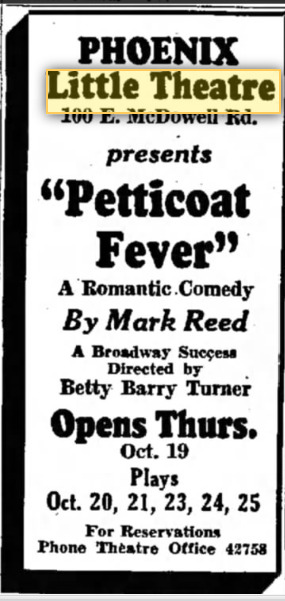
- Kind Lady
- GROWING PAINS
- Playwright: Aurania Ravenol.
- The Play: A work for children.
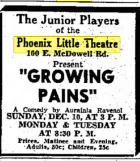
- Our Town
- In Old Kentucky
- Both Your Houses
- Susan and God
- The Animal Kingdom
- RACKETTY, PACKETTY HO– USE
- Playwright: Francis Hodson Burnett
- Director: Mrs. F.E. Berger
- The Play: A family-friendly tale of dolls who live in the dollhouse in a little girl’s nursery.
